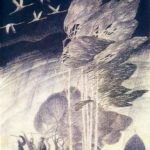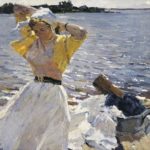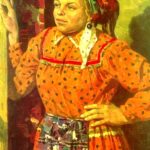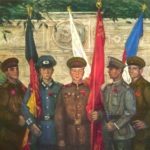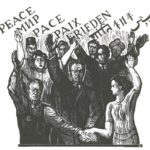Soviet artist Vladimir Mayakovsky
Soviet artist Vladimir Mayakovsky
Although many know Mayakovsky as a poet, tribune, he made several thousand drawings and most of the texts to them. And if he had not entered the world culture as a poet, he would have remained in history as the creator of a new surprising revolutionary art. “Everything for everyone!” – shouted big red letters on the billboard poster “20 years” at exhibition organized by Mayakovsky in February 1930 in the Club of the Federation of Writers in Moscow. The title of the poster expressed the main principle of work of the great poet, essayist, playwright, actor, and artist. The talent of artist manifested itself earlier than all the others. Meanwhile, in the family of Mayakovsky all could draw well. In particular, father Vladimir Konstantinovich (by the way, many pieces of furniture in the house were made according to his drawings), mother Alexandra, and sisters Olga and Lyudmila.
Lyudmila was preparing to enter the Stroganov School of Industrial Art and took painting lessons in Kutaisi, where Mayakovsky lived. She showed her art teacher S. Krasnukha pictures of her brother Vladimir Mayakovsky. Since that time S. Krasnukha taught Mayakovsky drawing lessons, for free. Lyudmila recalled that the artist paid much attention to her brother, “would sit with him, not counting the time, carried away with lessons. He told about Russian and Western painting, about the individual artists … the lessons were interesting. We have become accustomed to the idea that Vladimir will be an artist.”
After the death of his father, in 1906, when mother and children moved to Moscow, this idea did not leave Mayakovsky. Vladimir began studying at school and at the same time attended evening classes at the Art Institute. The family lived difficult. Along with Ludmila Vladimir painted boxes, Easter eggs. In those years he drew a lot, mostly portraits. From his earliest works preserved pencil portrait of I. Morchadze, professional revolutionary, who lived in the family of Mayakovsky.
Fourteen year-old young man, Vladimir joined the Bolshevik Party. For his revolutionary activities he was arrested three times. Active by nature, while in prison, he decided to educate himself. From a police unit in January 1909 he wrote a letter, asking his elder sister to bring him Marx’s “Capital”, fiction, textbooks, and watercolors. “If you find (try to), then bring Gnedich’s “History of Art” and Muter’s “History of Painting in the 19th Century… . Allowed are paints and drawing tools, only if they are of small size. Yes, bring two more brushes …” Unfortunately, the drawings made in prison, did not survive.
The first longing after the release from prison – to study. At that time, Mayakovsky felt the desire to create socialist art. Behind him, aged sixteen, was already the harsh school of life, “the right attitude to the world,” but a small knowledge base. While in prison were written the first verses of Mayakovsky and 191O was the beginning of poetic activity. Despite this, he was still going to be a painter. His skill was formed in Stroganov, art studios, the School of Painting, Sculpture and Architecture.
He studied in School of Painting, Sculpture and Architecture for more than two years. It was the only professional education he received. Contemporaries recall the material difficulties of Mayakovsky family. But neither poverty nor the prison could break the will and character of the artist. Learning old, looking for a new, he paved his own way in art.
The catalogs of exhibitions of 1912-1915 indicated a variety of works by the young artist: landscape “The Volga”, “Portrait of a Woman”, caricatures, Agitprop posters. In the collection of the State Museum of Mayakovsky – three early paintings: “A woman in a fur coat,” “The Model”, “Piece of iron.” The drawings were made in different techniques: pastel, ink, watercolor, charcoal, pencil. The poet felt need to draw so much that, when there was nothing at hand, he dipped cigarette butts into ink, or used burnt matches. He painted animals: dogs, zebras, crocodiles. Preserved whole series of his giraffes.
Thirst to paint remained for life. Drawings speckled notebooks with handwritten signatures of the poet verses. Here you can meet the friendly caricatures of writers, friends, self-caricatures. In his largest notebook – drawings made during a trip to Mexico and America in 1925. Among them, a portrait of the American artist Hugo Gellert. Here, by hand of Gellert – inscription in English: “My God, you are not only a great poet, but also an artist.”
In the museum of the poet, in the room where he lived and worked, now, as in life it can be seen on the desktop next to a pen and notepad with poetic blanks with ink bottles, tubes of paint. Fine art never ceased to interest Mayakovsky. Articles of Mayakovsky about painting tell of a meeting with Picasso, F. Leger, of great interest to their work. Like poetry, art was for Mayakovsky one of the most important forms of communication with people.
Working in 1917 on the popular prints in publishing house “Parus”, headed by Maxim Gorky, using the classical traditions of Russian folk images, he makes it clear in the art for the masses, new images and techniques that seek to put at the service of struggling people – cheap popular poster. Great October Socialist Revolution was the meaning of life for Mayakovsky – “My Revolution”. He gives all his talent to it. Courage, innovation, inexhaustible energy are characteristic for Mayakovsky – a poet and artist.
Make Art, worthy of time, always keep work from real observations of life – he required, no matter what genre he worked: performing sketches of scenery for their own plays or candy wrappers, processing books, making posters, creating a “Windows of ROSTA”. In the difficult and heroic days of the Civil War, when time itself required new forms of propaganda art, capable of rousing the masses to fight the enemy, were born the legendary “Windows of ROSTA”. The first posters appeared in the summer of 1919 to replace the printing of the “wall paper”.
Stunning working ability of the poet, the desire of all to work for the sake of revolution, were an example for all artists. Often, for one day Vladimir Vladimirovich made up to 50 posters. “Windows of ROSTA” – a fantastic thing. People were waiting for posters, which clearly explained what interested all, which explained the decisions of the Communist Party, smashed white on all fronts, restored the economy, responding to the question, what to do in this situation.
Created in nearly 50 cities across the country, the impact of “ROSTA” poster was huge. Undoubtedly, this art has become a truly national. “Frantic pace of the revolution” demanded a simple and quick drawing. Here Mayakovsky got very useful experience in the cheap popular poster. In the “Windows of ROSTA” Mayakovsky – a poet and artist – used tricks of the national popular print, freeing him from the stamps and decorations, found economical color solution. The main requirement, according to Mayakovsky – its clarity for the person for whom it is created. Drawings must be catchy.
























